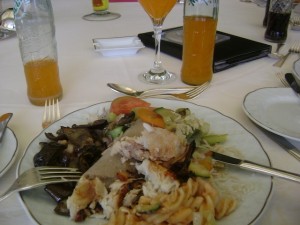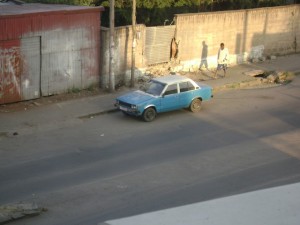From this recent article about Ethiopian Airlines, it was shocking to learn that African airlines now account for about 20% of air traffic to and from the continent, down from 60% three decades ago. This was according to Ethiopian Airlines Group CEO Tewolde Gebremariam. According to Wikipedia, which has a list of the largest airlines in Africa by passenger numbers (2013), the top African airlines are:
1 EgyptAir 11.8 million (M) passengers
2 South African Airways 9.5M
3 Royal Air Maroc 6.2M
4 Ethiopian Airlines 6M
5 Air Algérie (4.4M in 2012)
6 Tunisair (3.8M in 10212)
7 Kenya Airways 3.6M
8 Arik Air 2.8M
9 Air Mauritius 3M
10 Libyan Airlines 1.3M
But what does Africa mean to these and other airlines? How does Africa impact these airlines financially? For some it’s clear, but for others, it’s difficult to judge as many carriers lump their (tiny) African operations with the Middle East and South Asia. Also, many airlines are state-owned and do not disclose investor levels of information that is useful for comparison.
A recent Qatar Airways financial report notes that the aviation industry in Africa is still in its early stages of development meaning that the continent is poorly served by its own national airlines. But alongside traditional extraction of natural resources, manufacturing, tourism and infrastructure investments are rising, which bodes well for the future economic and political stability of the African continent. Increasing air-connectivity between Africa and the rest of the world will drive economic growth. Another one from Ethiopian notes that jet fuel is 21% more expensive in Africa compared to the rest of the world.
Here are extracts from the annual reports and official releases of the various airlines:
Air Algerie: Flew 5 million passengers on 56 aircraft.
British Airways: Flies to 16 destinations in Africa.
Chinese Airlines: Have only recently started flights to Africa, and travel between Africa and China is mainly by African airlines and the Gulf carriers. Of the six state-owned airlines, Air China flies to Ethiopia and South Africa, while China Southern flies to Kenya.
Egypt Air: Their report notes that African airlines not able to achieve adequate load factors except on a few routes and the airline operates in a territory that has lots of disruptions, cancellations, and flight & route changes due to security. The state airline comprises an international airline, a local airline, industrial training, ground handling, medical, in-flight catering, and other arms. It had 2015 revenue of 17.7 billion pounds (~$2.5) billion of which 7.5 billion pounds was from airline passenger flights in which they carried 7.4 million passengers (plus another 1.2 million in the sister domestic airline). 52% of their revenue is from the Middle East was 52%, followed by 21% from Europe. No number is given for ‘Africa’ but the report notes that African revenue declined 25% from 2014.
Emirates: Now flies to 154 cities in 83 countries. In 2016, revenue from Africa was 9 billion AED (~$2.5 billion), a 3% decrease from 2015. Africa accounts for 11% of Emirates overall revenue of their 84 billion revenue. 29% comes from Europe, 27% from East Asia, 14% from America, and they only get 10% from the Gulf & Middle East – a truly international airline. Also, Dubai Tourism statistics show that only 5% of visitors to Dubai are from Africa, led by Egypt (239,000) and Nigeria (139,000). Emirates get 32% from travel services, 27% from UAE airport operations, 20% from international airport operations, and 18% from catering.
Ethiopian Airlines: Flies to 49 destinations in Africa. It had 2015 revenue of 49 million birr (~ $2.1 billion) and 3.5 billion birr (~$160 million) profit and is one of the few consistently profitable airlines on the continent. They have huge investments in Asky Airlines (ECOWAS airline based in Lome that flies 10 000 passengers a week to 22 destinations in 20 countries of West and Central Africa) and Malawi Airlines. Another post mentions that Ethiopian Airlines has proposed a joint pan-African airline for the under-served Southern and Central Africa regions to the governments of Zambia, Zimbabwe, Uganda, Rwanda, Namibia, DRC and Botswana.
Etihad Airways: Own 40% of Air Seychelles and flies to 166 destinations using 120 aircraft (2014). Has 49 code-share partnerships including with Kenya Airways, South African, and Royal Air Maroc. Their 2014 revenue was $7.6 billion, with a profit of $73 million profit (no further breakdown).
Kenya Airways: In 2015, 49% of its Kshs 110 billion ($1.2 billion) revenue was from the rest of Africa (down from 52%). 22% was from Europe, 19% from Asia and 10% from local flights in Kenya. So is KQ’s dependence on Africa is a drawback?
Lufthansa: Flies to 17 destinations in 14 countries in Africa. In 2015, it had 583 million Euros (~$608 million) of revenue from Africa (unchanged from 2014), and this is about 2% of their overall revenue.
(Air) Mauritius: In 2015, had 490 million euros of revenue (about $600 million) and a net profit of 16.5 million euro (compare to a loss of 24 million euros the year before) They carried 1.5 million passengers and flew to 23 destinations. Europe has been their main market (34% of revenue) followed by Asia 32% (they have the largest Asian network of any African airline). In Africa, they fly to 6 destinations, and 29% of their revenue is from a combined Africa/Middle East/Indian Ocean zone, earning 39.5 million euros ($49 million). The flew 247,000 passengers in Africa, a 10% increase.
Qatar Airways: Flies to 26 African destinations (out of 150 total) and plans to add more in Africa and India which they expect will be the largest growth markets in the near to medium term. In 2016, they carried 26.6 million passengers.
South African Airways: Generated 589 million rand (~$42 million) from its African routes and notes that Africa continues to have strong underlying growth. They had a fleet of 50 aircraft in 2016 and are trying to grow a hub in West Africa.
TunisAir: Flew 2.7 million passengers in 2015, which was down from the average of 3.7 million they have carried in past years. Some of this can be attributed to curfew hours and increased security.
Turkish Airline: Got $826m from African sales in 2015 (a 9% decline from 2014). Africa accounts for 8% of revenue and passenger volumes and they fly to 48 destinations in 31 countries on the continent using a narrow body i.e. 737 fleet of aircraft. Turkish Airlines sells 10,000 tickets per day in Africa.







